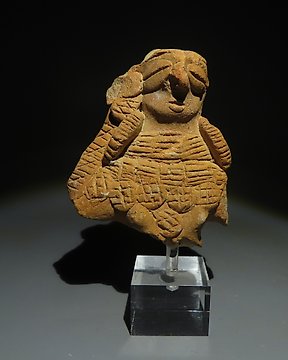
Harappa Terracotta Torso di divinità femminile. 2500-1900 a.C. 8,5 cm di altezza. (Senza Prezzo di Riserva)
N. 83494365

N. 83494365

Paccha-shaped vessel (foot plough).
Inka, c. 1470 - 1534 AD.
Terracotta.
37 cm length.
PROVENANCE: - Collection of Jean Pierre Cottier and Fiorella Cottier-Angeli, Geneva, Switzerland. Acquired by Yossef Maiman between 2000-2008.
Most of the items in the Cottier collection were acquired between the 1960s and 1980s from prominent collectors such as Carlos Campilli (Miami), Sophie Pdgorska (Geneva) and Marguerite Motte (Paris).
CONDITION: Good condition. Small nick on the upper lip.
DESCRIPTION:
The Inka people originated in the groups that inhabited the Cuzco Valley in the Late Intermediate Period. These groups began to expand their territory by conquering neighboring peoples, and eventually formed one of the most extensive Empires of antiquity. The Inka established many different kinds of relations with different ancient peoples, and their strategy of conquest included diplomacy, reciprocity (through gift-giving) and alliances, although all of these approaches were backed by the presence of a strong and highly experienced armed force. In 1532, the Spanish conquistadors arrived on the coasts of Peru and, led by Francisco Pizarro, took advantage of the conflict between two factions—one led by Huáscar, the other by Atahualpa—and in a few short years put an end to the Empire known as Tawantinsuyu.
The Inka produced art in many forms, but ceramics, textiles and metals are especially important ones. Notable among their many ceramic traditions is the Inka Imperial style, manufactured in Cuzco. These pieces had a cream-colored finish and red and black painted decoration that usually consisted of geometric motifs such as “fern” patterns or lines of diamonds. One of the most emblematic Inka ceramic vessels is the aríbalo or maka, a narrow-necked jug with flared edges, a spherical body, two handles and a narrow base. These jugs often were made in the shape of a feline and were typically used as containers for chica, a locally-made fermented beverage. The finest examples served as prestige goods, and were given as gifts by the Inka ruler to seal alliances or to maintain relations of reciprocity for political purposes.
Textiles were also highly valued in Inka society. The most prized of these were made of multicolored alpaca or vicuña wool using a variety of techniques and decorated with geometric figures. Metal crafts, especially copper, gold and silverwork, was also highly developed in the Inka empire. Some well known examples are the human and camelid figures made of noble metals and left as offerings on high mountain shrines and the tupus, pins used to hold women’s blankets. They also produced a wide array of objects used for ceremonial and ritual purposes. In the outlying provinces, local versions of many of these items were made, particularly ceramic pieces, which disseminated the Inka esthetic and political-religious symbolism while in many cases incorporating regional stylistic patterns.
Notes:
- The piece includes authenticity certificate.
- The piece includes Spanish Export License.
- The seller guarantees that he acquired this piece according to all national and international laws related to the ownership of cultural property. Provenance statement seen by Catawiki.
Come fare acquisti su Catawiki
1. Scopri oggetti speciali
2. Fai l’offerta più alta
3. Paga in tutta sicurezza